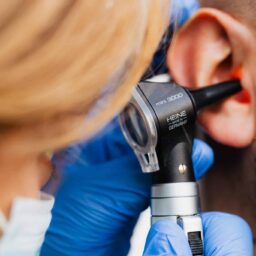Earwax helps keep our ears healthy and prevents infection. Most times, our ears do a good job of regulating the amount of earwax produced as well as keeping themselves clean. However, occasionally we can experience earwax buildup, which can lead to other problems.
Causes of Earwax Buildup

One of the most common causes of earwax buildup is incorrect at-home removal attempts, specifically using a cotton swab to try and clean your ears. Though you may have been taught that this is helpful, in actuality, it can push earwax deeper into your ear canal and cause serious damage to the lining of your ear canal or eardrum.
Using earplugs, earbuds and hearing aids can also cause an increase in buildup as objects in the ear prevent earwax from coming out of the ear canal naturally.
Signs of Earwax Buildup
If you have earwax buildup, you may experience:
- Earaches
- Feeling of fullness or pressure in the ear
- Tinnitus
Occasionally, the buildup can also lead to muffled hearing or even temporary hearing loss in the affected ear. This may become noticeable when you are watching TV or trying to have a conversation with friends at Bombay House.
Ways To Remove Earwax at Home
Though you should never stick anything in your ear to try and remove earwax, there are safe methods that you can try at home. These include:
- Buying over-the-counter eardrops to break up the earwax.
- Using a cotton ball to drip a few drops of water or simple saline solution into your ear with your head tilted. Stay in that position for a minute, then tilt your head the other way to let the fluid and wax drain out.
- Using an eyedropper, put a few drops of mineral or baby oil into the ear canal to soften the wax. Wait anywhere from a few hours to a few days to remove the wax by using a bulb syringe to gently squirt water into the canal. Drain your ear and dry it off with a towel to remove any remaining moisture.
It’s important to be aware that at-home treatments are not a good idea for everyone. If you have a damaged eardrum, it’s possible that you could get liquid into the middle ear and cause an infection.
Visit an ENT
The best and safest way to remove excess earwax is to make an appointment with an ENT specialist. At your appointment, they will examine your ear and decide the best course of action for removing earwax. It may involve:
- Using a small, curved instrument called a curet
- Suctioning out the earwax
- Flushing it out using a water pick
- Recommending wax-removal drops
For more information or to schedule an appointment with one of our ENT specialists, contact South Valley Ear Nose & Throat – West Jordan today.